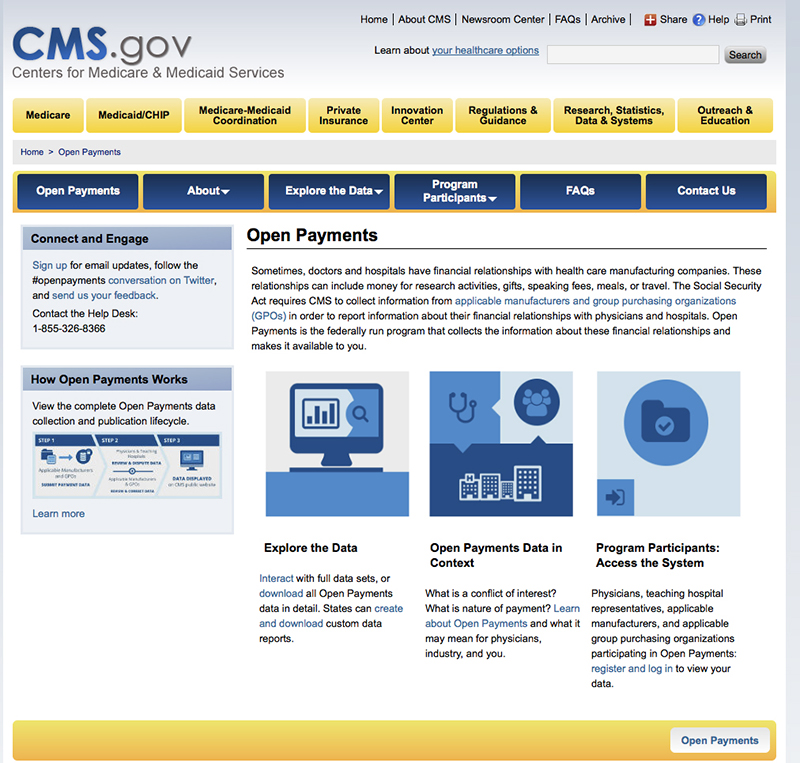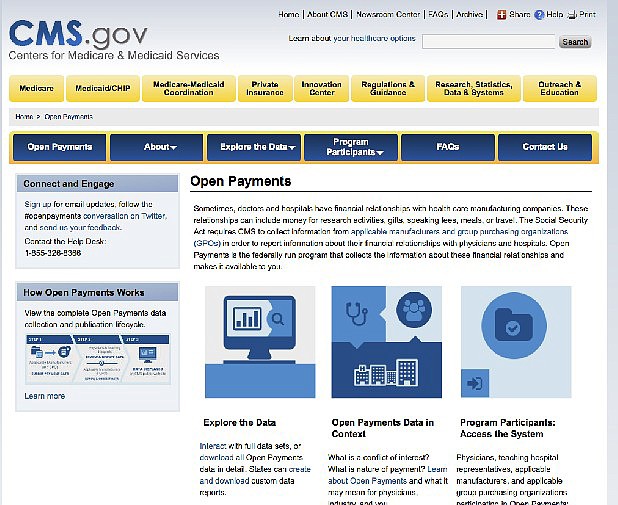 This image provided by the Department of Health and Humans Services shows the homepage of the Centers for Medicare & Medicaid Services. From research grants to travel junkets, drug and medical device companies paid doctors and leading hospitals billions of dollars last year, the government disclosed Tuesday in a new effort to spotlight potential ethical conflicts in medicine. Industry spent nearly $3.5 billion on such payments in the five-month period from August through December of 2013, according to the Centers for Medicare and Medicaid Services, which released data on 4.4 million payments.
This image provided by the Department of Health and Humans Services shows the homepage of the Centers for Medicare & Medicaid Services. From research grants to travel junkets, drug and medical device companies paid doctors and leading hospitals billions of dollars last year, the government disclosed Tuesday in a new effort to spotlight potential ethical conflicts in medicine. Industry spent nearly $3.5 billion on such payments in the five-month period from August through December of 2013, according to the Centers for Medicare and Medicaid Services, which released data on 4.4 million payments.WASHINGTON - From research grants to travel junkets, drug and medical device companies paid doctors and leading hospitals billions of dollars last year, the government disclosed Tuesday in a new effort to spotlight potential ethical conflicts in medicine.
Industry spent nearly $3.5 billion on such payments in the five-month period from August through December 2013, according to the Centers for Medicare and Medicaid Services, which released data on 4.4 million payments.
The massive trove of information named companies and many of the recipients. Also listed were types of payments, with details down to travel destinations. Some 546,000 clinicians and 1,360 teaching hospitals received payments. Some doctors had ownership stakes in companies.
It's part of a new initiative called Open Payments, mandated by President Barack Obama's health care law. It was intended to allow patients to look up their own doctors online, but that functionality isn't fully ready yet. In future years, the information will cover a full 12 months and will be easier to search, officials said.
Consumer groups called the move a much-needed step toward transparency about relationships that can influence patients' care. But doctors and industry said the government rushed to release the data, and they raised questions about accuracy and lack of context. The administration said it's not pointing a finger at the medical profession or the pharmaceutical industry.
"Open Payments does not identify which financial relationships ... could cause conflicts of interest," said Shantanu Agrawal, the agency official overseeing the project. "It simply makes the data available to the public."
Under Obama, government policy has shifted toward opening the books of the medical profession. A few months ago Medicare released its huge claims database, showing program payments to more than 825,000 providers for 2012. Unlike other provisions of his health care law, Open Payments is supported by lawmakers of both political parties.
Drug companies traditionally have prized their relationships with doctors, the gatekeepers between patients and prescription medications. But consumer groups see a built-in conflict of interest that can influence prescribing decisions, the use of high-tech tests, and even types of surgeries performed.
Some doctors' offices have started curbing pharmaceutical marketing, which can include anything from free pens and pizzas to paid speaking engagements and golf outings at fancy resorts. Clinical research is another area of financial relationships, and harder to assess. Many doctors receive significant payments to help drug companies conduct research, which can benefit society.
The American Medical Association said it was "extremely concerned" about release of the payments file, adding that the data may contain inaccuracies and lacks context to help the average person evaluate the information. The administration provided individual doctors an opportunity to inspect their data prior to release, but the AMA says the window was short and the process cumbersome.
Consumer groups call the disclosure program the "Sunshine Act," and say it's overdue.
"Research has shown over and over that these financial relationships influence doctors, even a meal," said John Santa, medical director for health projects with Consumers Union. "Studies also show that doctors believe it does not affect them, but strongly believe it affects other doctors."
AMA President Robert Wah said in a statement that some financial dealings between doctors and the drug industry help patients, particularly when it comes to research. There are "appropriate relationships in this realm that can help drive innovation in patient care," Wah said.
The information released Tuesday covers payments by drug and medical device manufacturers to doctors and teaching hospitals. Also reported were certain ownership stakes. Manufacturers must report payments and gifts unless they are valued at under $10. Doctors, dentists, podiatrists, optometrists and chiropractors are covered.
The data, however, are preliminary. Officials said identifying details were removed in about 40 percent of the records because of unresolved questions. Another 300,000 records are still being verified, and were not included, so the total value of payments is expected to be higher.
The disclosure provision was championed in Congress by Sen. Charles Grassley, R-Iowa, who said he hopes the data will become a resource for consumers over time.
"The patient who is prescribed a drug that might be beneficial yet risky will be able to learn whether the prescribing doctor accepted drug company money to study the risks." Grassley said in a statement. "The information might not change the outcome, but it's something a patient might like to know."
Others worry it will discourage doctors from participating in research.
"My biggest concern is it will have a chilling effect and physicians will say 'I don't want to see my name on a list,'" said Mary Grealy, president of the Healthcare Leadership Council, an umbrella group that includes doctors, hospitals and drug companies. She would like to see the $10 reporting threshold increased, and more context on payments for research.
